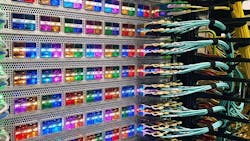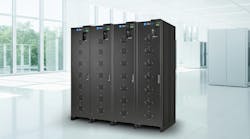In AI Arms Race, Data Centers Are the Table Stakes for Hyperscale Players
Hyperscale tech companies and global investment firms continue to invest heavily in digital infrastructure for AI, citing it as a game-changing technology for society and the economy.
But after a selloff in the tech sector, some stock investors are assessing the timing of the payoff on these big bets on AI. As securities analysts scrutinize timelines for a return on that investment, the tech titans say they will continue to invest in data centers, which they see as table stakes to compete in an AI-powered future.
That means the data center construction boom is likely to continue, with space in short supply and future capacity being fully pre-leased, often before shovels even hit the dirt. It also means that the financial risk of the AI boom lies primarily with hyperscale tenants, rather than developers or their sponsors.
Any risk of oversupply may also be moderated by the constraints on electric power and equipment, analysts say. This could extend delivery timelines for new data centers, but also reduces the possibility that IT facilities will be sitting empty if AI business is slow to materialize.
The tech titans say they are encouraged by early adoption of their AI offerings and are not slowing their investment.
This week’s earnings reports indicate the 4 major hyperscalers - AWS, Google, Microsoft and Meta - are investing about $50 billion per quarter on digital infrastructure, including GPUs for AI computing and the data centers to house them. That spending is likely to continue into next year, and may even increase, companies indicated.
This upbeat outlook has boosted shares of companies on the forefront of the AI boom, including NVIDIA, Microsoft, Google and players in the GPU production ecosystem.
But some bellwethers of the AI rally in the stock market are hitting serious turbulence. Share prices of Supermicro and NVIDIA have each slid about 20 percent over the last month amid broader losses for stocks. Although the selloff is widely attributed to worries about a slowing economy, analyst concerns about valuations for AI-focused players have contributed to the downturn in tech shares.
Despite the recent slide, Supermicro (+200%) and NVIDIA (+55%) still boast strong year-to-date returns.
Blackstone Sees $1 Trillion in Data Center Spending
The world’s largest investors see AI as a game-changing technology, with digital infrastructure playing a key role in societal transformation.
“I believe the consequences of AI are as profound as what occurred in 1880 when Thomas Edison patented the electric light bulb,” said Stephen Schwarzman, Chairman and CEO of Blackstone. “Current expectations are that there will be approximately $1 trillion of capital expenditures in the United States over the next five years to build and facilitate new data centers.”
Blackstone knows about trillions. It is the world’s largest alternative asset manager, with more than $1 trillion in assets under management. It owns and operates QTS Data Centers, and invested in many other projects and companies, with a total portfolio of $55 billion of data centers, with over $70 billion in prospective pipeline development.
It’s not just a bet on the future, either. It’s generating returns now. “Our data center platform was the single largest driver of appreciation in our real estate and infrastructure businesses and for the firm overall in the second quarter,” said Michael Chae, Chief Financial Officer of Blackstone, in an earnings call.
Will 2025 Be the Year of the Data Center?
Firms such as Blackstone have plenty of company, according to CBRE’s annual investor sentiment survey. “Data centers continue to benefit from greater investment, particularly from new investors,” CBRE reports. “Ninety-seven percent of respondents to this year’s survey, many of whom are the world’s largest institutional real estate investors, plan to increase their capital deployment in the data center sector this year.”
Some examples of that optimism:
- “We believe that 2025 will be the ‘Year of the Data Center’ and that we are on the cusp of transitioning from a hype cycle into an industrial-driven build cycle,” writes David Cahn at Sequoia Capital.
- “Two megatrends are driving the demand for data center capacity and will continue doing so in the years to come: organizations migrating their data from on-site servers into the cloud and the rise of artificial intelligence (AI),” writes KKR, which has backed that thesis through acquisitions of CyrusOne and CoolIT Technologies.
- “Soaring GPU demand is rippling across the global economy, but no area has been more affected than data centers,” says the analyst team at Jefferies. “Over the past two years, data center demand has skyrocketed, surging to over 30% annual growth in some key markets.”
Hyperscale operators remain confident in their current level of infrastructure spending, and see limited risk in overbuilding.
Meta CEO Mark Zuckerberg said that he would "rather risk building capacity before it is needed, rather than too late, given the long lead times for spinning up new infra projects."
“We are at an early stage of what I view as a very transformative area in technology,” said Sundar Pichai, the CEO of Google. “When we go through a curve like this, the risk of under-investing is dramatically greater than the risk of over-investing. Even if it turns out that we are over-investing, these (GPUs and data centers) are infrastructure which are widely useful for us.”
With $19 billion in capex last quarter, Microsoft has been making the largest investments in AI. CFO Amy Hood said about half of that was for servers (CPUs and GPUs) and half for data center capacity. That includes a growing reliance on data center developers.
“We are constrained on AI capacity,” said Hood on the earnings call. “Because of that, we have signed up with third parties to help us as we are behind with some leases on AI capacity.”
At DCF we have been tracking the power constraints in key markets and resulting data center space crunch (see our 2024 forecast for more on this). Some analysts believe this reduces the risk of an AI bubble.
“The pressing question is: Can supply keep up?” writes Jefferies. “Market constraints — including scarce raw materials, limited land, labor shortages, and construction bottlenecks — pose serious challenges. Most critically, power generation and grid capacity are lagging.”
While this may slow delivery timelines, in the long term there may be a silver lining for the planet.
“One beneficiary of the data center boom may be the global energy transition,” says Jefferies. “The growth in data centers is expected to help renewable power developers reduce risk by allowing them to form longer-term contracts at higher prices.”
“AI will catalyze an energy transformation,” predicts Sequoia Capital. “New solar construction, battery innovation, a resurgence in nuclear energy—these will be long-term effects of the AI wave.”
Will AI Deliver on its Promise? And When?
One prominent dissenter to the bull case is Goldman Sachs equity analyst Jim Covello.
“My main concern is that the substantial cost to develop and run AI technology means that AI applications must solve extremely complex and important problems for enterprises to earn an appropriate return on investment (ROI),” Covello said in a Goldman Sachs research note. “What $1 trillion problem will AI solve? Replacing low-wage jobs with tremendously costly technology is basically the polar opposite of the prior technology transitions.”
Sequoia’s Cahn also perceives a gap between the revenue expectations implied by the AI infrastructure build-out and actual revenue growth in the AI ecosystem but says investors taking the long view will be rewarded.
“A huge amount of economic value is going to be created by AI,” Cahn writes. “Speculative frenzies are part of technology, and so they are not something to be afraid of. Those who remain level-headed through this moment have the chance to build extremely important companies. … In reality, the road ahead is going to be a long one. It will have ups and downs. But almost certainly it will be worthwhile.”
And as KKR notes in its analysis, you still need to pick the right kinds of picks and shovels.
“Knowing how to value these investments is also critical,” write KKR’s Waldemar Szlezak and Andrew Peisch. “We have observed other investors acquiring legacy data centers that may no longer be suited for tomorrow’s computing needs or that may not have the power sources in place to support customer growth plans. It is important for data center players to be able to call on experts in areas such as real estate, energy, technology, policy, and climate issues to help identify and appropriately underwrite digital infrastructure investments.”
What if it takes longer for AI businesses use cases to emerge? Large-scale IT services cannot run without data centers, which are expensive to build. But the risk equation for data center development has changed dramatically since the dotcom bust era of the early 2000s, when service providers constructed entire multi-tenant facilities and then sought to fill them with customers, many of them startups.
In today’s supply-constrained market, most data center deals involve single-tenant projects that are fully leased to large tech companies with excellent credit, often before construction has begun. This pre-leasing reduces the risk for the developers and investors. If AI services take longer to gain traction, hyperscale customers might take longer to fill their data center space with servers.
There’s Tension in Technology Timelines
The current discussion echoes similar discussions about cloud computing, and whether enterprises would ever feel comfortable moving workloads into the cloud. Those with good memories may recall Larry Ellison’s rants about cloud hype, but it wasn’t long before cloud became a big business for Oracle.
Some industry veterans say skepticism is part of any major technology transition, as recently noted by Daniel Golding, Chief Technology Officer at Appleby Strategy Group.
“Many of us in the infrastructure field had been anticipating this for some time,” Golding writes in an analysis on LinkedIn. “That’s because the AI hype cycle has been working overtime. NVIDIA’s leadership - and everyone else - has been extolling the world changing aspect of AI. And changing the world isn’t cheap - it's a hundreds of billions of dollars endeavor which will produce tens of trillions in returns … eventually.
“And therein lies the problem. The investment timeline for Goldman and for many of the private equity firms in the sector, is mismatched with the reality of paradigm-shifting technologies. The actual timeline for really transformative AI is 5 to 10 years, during which there will be a LOT of investment and a LOT of technological advancement, with accompanying shifts in our society and economy.
“The good news is, the hyperscalers won’t get cold feet quite so easily,” Golding concludes. “Goldman is the first and won’t be the last to have a shortfall of intestinal fortitude. But there are plenty of others who will take the risk and adjust their investment strategy accordingly.”
About the Author



